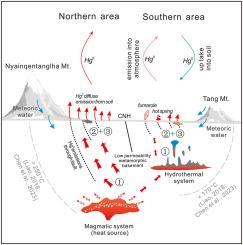IF 3.4
3区 地球科学
Q1 GEOCHEMISTRY & GEOPHYSICS
引用次数: 0
摘要
汞(Hg)是一种易挥发、有毒的微量金属。气态单质汞(Hg0)是大气中汞的一种普遍形式,被认为是一种危险的污染物,对人类和环境都有各种不利影响。火山活动特别活跃的大陆俯冲带是发现含汞带的重要而独特的区域。本文对位于印度-亚洲大陆俯冲带的羊八井(YBJ)地热田的Hg0排放量进行了定量估算。分析认为,土壤扩散排放和喷气孔脱气是YBJ地热田Hg0排放的主要形式。YBJ地热田南北地区Hg0排放差异显著。北部和南部土壤扩散排放和南部喷气孔脱气的Hg0排放通量分别为107.5 ~ 31,954.2 ng m−2 d−1、2.8 ~ 11039.3 ng m−2 d−1和28.7 ~ 73,229.4 ng m−2 d−1。南北地区的Hg0排放在空间上均沿北东向断裂分布。这一发现说明了地质构造环境对地热田Hg0排放的影响。除Hg0通量外,南北地区的气体组成、碳同位素、微生物群落丰度、细菌和古细菌多样性均存在显著差异。这些差异表明北部和南部地区的Hg0排放分别来源于岩浆和热液系统。YBJ地热田的Hg0排放主要由岩浆和热液脱气、热释放和微生物活动引起。研究表明,大陆俯冲带是Hg0脱气的重要区域。未来的研究重点应放在大陆俯冲带的Hg0排放上。本文章由计算机程序翻译,如有差异,请以英文原文为准。

Gaseous elemental mercury emissions in the Yangbajing geothermal field, Tibetan Plateau
Mercury (Hg) is a volatile, toxic trace metal. Gaseous elemental mercury (Hg0) is a prevalent form of Hg in the atmosphere and is considered a dangerous pollutant with various adverse effects on both humans and the environment. The continental subduction zone, where volcanism is particularly active, is an important and unique area where the mercurriferous belt is found. In this work, a quantitative estimation of the Hg0 emissions in the Yangbajing (YBJ) geothermal field, which is located in the Indian–Asian continental subduction zone, was performed. According to our analysis, soil diffuse emission and fumarole degassing were the main forms of Hg0 emissions in the YBJ geothermal field. Significant differences in Hg0 emissions were observed between the northern and southern areas of the YBJ geothermal field. The Hg0 emission fluxes from soil diffuse emissions in the northern and southern areas, as well as fumarole degassing in the southern area, were 107.5–31,954.2 ng m−2 d−1, 2.8–11,039.3 ng m−2 d−1, and 28.7–73,229.4 ng m−2 d−1, respectively. Furthermore, the Hg0 emissions in both the northern and southern areas were spatially distributed along the NE-trending fault. This finding demonstrated the influence of geological tectonic setting on the Hg0 emissions in the geothermal field. In addition to the Hg0 flux, the gas compositions, carbon isotopes, microbial community abundance, and diversity of bacteria and archaea in the northern and southern areas exhibited significant differences. These differences indicated that Hg0 emissions in the northern and southern areas originated from magmatic and hydrothermal systems, respectively. The Hg0 emissions in the YBJ geothermal field are attributable to magmatic and hydrothermal degassing, thermal release, and microbial activities. Our work indicated that continental subduction zones are important areas of Hg0 degassing. Future research should focus on Hg0 emissions in continental subduction zones.
求助全文
通过发布文献求助,成功后即可免费获取论文全文。
去求助
来源期刊

Applied Geochemistry
地学-地球化学与地球物理
CiteScore
6.10
自引率
8.80%
发文量
272
审稿时长
65 days
期刊介绍:
Applied Geochemistry is an international journal devoted to publication of original research papers, rapid research communications and selected review papers in geochemistry and urban geochemistry which have some practical application to an aspect of human endeavour, such as the preservation of the environment, health, waste disposal and the search for resources. Papers on applications of inorganic, organic and isotope geochemistry and geochemical processes are therefore welcome provided they meet the main criterion. Spatial and temporal monitoring case studies are only of interest to our international readership if they present new ideas of broad application.
Topics covered include: (1) Environmental geochemistry (including natural and anthropogenic aspects, and protection and remediation strategies); (2) Hydrogeochemistry (surface and groundwater); (3) Medical (urban) geochemistry; (4) The search for energy resources (in particular unconventional oil and gas or emerging metal resources); (5) Energy exploitation (in particular geothermal energy and CCS); (6) Upgrading of energy and mineral resources where there is a direct geochemical application; and (7) Waste disposal, including nuclear waste disposal.
 求助内容:
求助内容: 应助结果提醒方式:
应助结果提醒方式:


